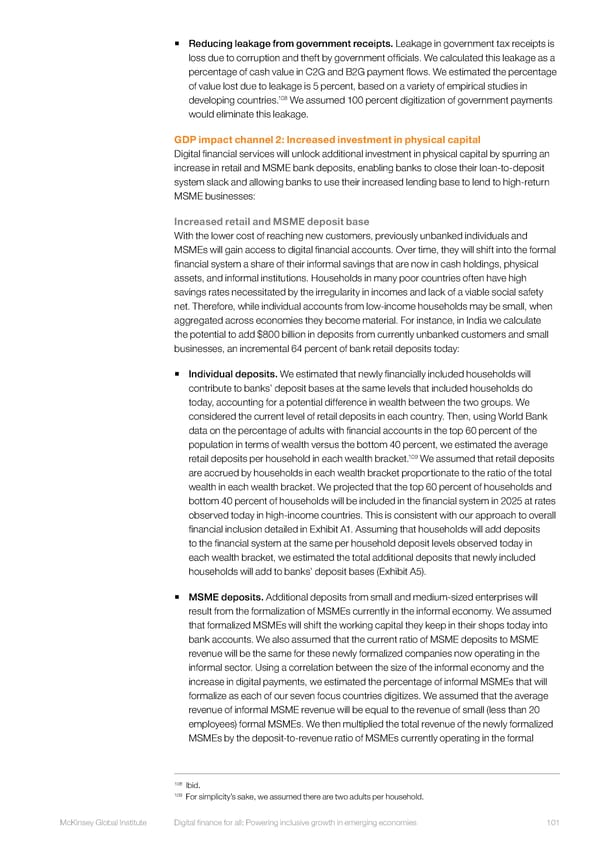ƒ Reducing leakage from government receipts. Leakage in government tax receipts is loss due to corruption and theft by government officials. We calculated this leakage as a percentage of cash value in C2G and B2G payment flows. We estimated the percentage of value lost due to leakage is 5 percent, based on a variety of empirical studies in 108 We assumed 100 percent digitization of government payments developing countries. would eliminate this leakage. GDP impact channel 2: Increased investment in physical capital Digital financial services will unlock additional investment in physical capital by spurring an increase in retail and MSME bank deposits, enabling banks to close their loan-to-deposit system slack and allowing banks to use their increased lending base to lend to high-return MSME businesses: Increased retail and MSME deposit base With the lower cost of reaching new customers, previously unbanked individuals and MSMEs will gain access to digital financial accounts. Over time, they will shift into the formal financial system a share of their informal savings that are now in cash holdings, physical assets, and informal institutions. Households in many poor countries often have high savings rates necessitated by the irregularity in incomes and lack of a viable social safety net. Therefore, while individual accounts from low-income households may be small, when aggregated across economies they become material. For instance, in India we calculate the potential to add $800 billion in deposits from currently unbanked customers and small businesses, an incremental 64 percent of bank retail deposits today: ƒ Individual deposits. We estimated that newly financially included households will contribute to banks’ deposit bases at the same levels that included households do today, accounting for a potential difference in wealth between the two groups. We considered the current level of retail deposits in each country. Then, using World Bank data on the percentage of adults with financial accounts in the top 60 percent of the population in terms of wealth versus the bottom 40 percent, we estimated the average 109 We assumed that retail deposits retail deposits per household in each wealth bracket. are accrued by households in each wealth bracket proportionate to the ratio of the total wealth in each wealth bracket. We projected that the top 60 percent of households and bottom 40 percent of households will be included in the financial system in 2025 at rates observed today in high-income countries. This is consistent with our approach to overall financial inclusion detailed in Exhibit A1. Assuming that households will add deposits to the financial system at the same per household deposit levels observed today in each wealth bracket, we estimated the total additional deposits that newly included households will add to banks’ deposit bases (Exhibit A5). ƒ MSME deposits. Additional deposits from small and medium-sized enterprises will result from the formalization of MSMEs currently in the informal economy. We assumed that formalized MSMEs will shift the working capital they keep in their shops today into bank accounts. We also assumed that the current ratio of MSME deposits to MSME revenue will be the same for these newly formalized companies now operating in the informal sector. Using a correlation between the size of the informal economy and the increase in digital payments, we estimated the percentage of informal MSMEs that will formalize as each of our seven focus countries digitizes. We assumed that the average revenue of informal MSME revenue will be equal to the revenue of small (less than 20 employees) formal MSMEs. We then multiplied the total revenue of the newly formalized MSMEs by the deposit-to-revenue ratio of MSMEs currently operating in the formal 108 Ibid. 109 For simplicity’s sake, we assumed there are two adults per household. McKinsey Global Institute Digital finance for all: Powering inclusive growth in emerging economies 101
 DIGITAL FINANCE FOR ALL Page 118 Page 120
DIGITAL FINANCE FOR ALL Page 118 Page 120